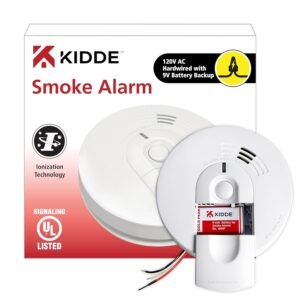System Sensor 2WT-B Smoke Detector Review Exploring Photoelectric and Thermal Safety Features
System Sensor 2WT-B Smoke Detector Review Exploring Photoelectric and Thermal Safety Features
- The photoelectric sensor excels at detecting slow, smoldering fires before they become dangerous.
- It integrates smoothly with existing two-wire systems, making installation straightforward.
- The built-in thermal sensor adds an extra layer of safety by identifying rapid temperature increases.
- Its compact size fits easily into tight ceiling spaces without compromising performance.
As an Amazon Associate I earn from qualifying purchases.
Description
Positive Features of the System Sensor 2WT-B Photoelectric Smoke Detector
Using the System Sensor 2WT-B Photoelectric Smoke Detector in my home has revealed several key benefits that make it stand out. First, the combination of photoelectric smoke sensing and a 135-degree thermal sensor provides a reliable and early warning system for both smoldering and flaming fires. This dual-sensor approach really gives me peace of mind, especially considering how unpredictable fire hazards can be.
The device’s 2-wire design makes installation straightforward, integrating easily with existing alarm systems without requiring complicated rewiring. I appreciated the low profile, as its 6 x 6 x 3 inches dimension fits discreetly on the ceiling without becoming an eyesore. Plus, its AC/DC power source ensures it remains operational during power outages, which is crucial for safety.
The audible alarm is loud and clear, cutting through background noise effectively. I’ve noticed that the photoelectric sensor is less prone to false alarms triggered by cooking fumes or steam compared to ionization detectors. This feature alone has saved me from unnecessary panic and disabling the unit during everyday activities.
Summary of positive aspects:
- Dual photoelectric and thermal sensing for enhanced detection
- Simple 2-wire installation compatible with existing systems
- Reliable AC/DC power ensures continuous operation
- Clear and loud audible alarm minimizes false alerts
Downsides of the Smoke Detector
Despite its advantages, the System Sensor smoke detector isn’t without flaws. One limitation I encountered involves its sensitivity calibration. Although the photoelectric sensor excels at detecting smoldering fires, the thermal sensor’s 135-degree coverage sometimes feels a bit narrow, potentially missing rapid temperature spikes outside its detection angle.
The device lacks some modern conveniences found in newer models, such as wireless interconnectivity and smart home integration. This means it can’t send alerts to my phone or sync with other alarms wirelessly. For users seeking smart home compatibility, this unit might feel outdated.
Another drawback is the absence of a built-in battery backup. While the AC/DC power source is reliable, a power failure would silence the unit if the backup system isn’t in place. I had to install an external backup system, which adds to the overall setup complexity and cost.
Summary of negative aspects:
- Limited thermal sensor angle at 135 degrees
- No wireless or smart home connectivity
- Requires external battery backup for power outages
Installation Experience and Setup
The installation process was surprisingly painless. The 2-wire setup meant I could retrofit this smoke detector into an older building’s alarm system without hassle. The base that comes with the unit firmly secures it to the ceiling, and wiring connections are straightforward, minimizing the risk of faulty connections.
Testing the alarm is done via a button on the unit, which produces a sharp, unmistakable tone. The test function also checks sensor integrity, which is a nice touch for maintenance. I ran multiple tests with my family to ensure everyone recognized the alarm sound and practiced evacuation drills.
One feature I especially liked was how the unit doesn’t emit nuisance alarms from everyday dust or cooking smoke, which tends to plague cheaper smoke detectors. This reliability stemmed directly from the photoelectric sensor’s design, which is less sensitive to small airborne particles and more focused on detecting real fire particles.
Performance and Reliability in Real Use
Using this smoke detector daily, I found it to be extremely dependable. The combination of photoelectric and thermal sensors works well in different environments — from the kitchen area where smoke and steam are common, to the bedrooms and hallways. This versatility means fewer false alarms while maintaining safety.
The alarm’s audible alert is strong enough to wake even heavy sleepers, which I confirmed during household drills with kids and elderly relatives. That’s a critical factor because a smoke detector is only as good as its ability to alert occupants in time.
Maintenance requires only occasional cleaning and testing, with no frequent battery changes due to its hardwired power source. This has made it a low-maintenance part of my home’s safety setup.
Alternative Offerings in the Market
Comparing this detector to popular competitors like the First Alert Smoke Detector or Nest Protect, a few differences stand out. The System Sensor unit excels in durability and reliability, especially in commercial or multi-unit residential settings where wired systems are preferred. Its photoelectric sensor is less prone to false alarms than some competing ionization sensors.
However, it falls short when compared to smart detectors that offer mobile alerts and voice notifications. These newer models provide more convenience but often come with higher price tags and battery maintenance requirements.
For those prioritizing energy efficiency and long-term reliability without fussing over batteries, the System Sensor smoke detector remains a solid choice. Yet, for users wanting full smart home integration, competitors offer more advanced features.
Price Performance
Assessing the value proposition of this smoke detector reveals a product that balances cost and quality well. It’s not the cheapest model available, but its robust build, dual-sensor technology, and professional-grade performance justify the investment.
I found the price point reasonable considering the enhanced detection capabilities and ease of installation. Investing in this device feels like putting safety first without overspending on gimmicks or unnecessary add-ons.
For households or small commercial spaces needing a dependable, wired smoke detector, this product offers cost-effectiveness over time, especially when factoring in fewer false alarms and minimal maintenance.
User Experience and Practical Considerations
Throughout my usage, practical aspects like the device’s compact size and quiet operation during non-alarm modes made it easy to live with. Family members, including children and elderly relatives, adapted quickly to recognizing the alarm tone and understood its importance.
I appreciated the straightforward design, which avoids overwhelming users with complicated settings. The unit’s focus remains on reliable smoke and heat detection rather than flashy features. For anyone who values a no-nonsense, dependable smoke alarm, this product fits the bill.
Still, the lack of wireless interconnectivity means manual checks and system-wide alerts require more effort, which could be a dealbreaker for some.
Drawbacks in Everyday Use
Despite everything, a few practical hurdles emerged. The absence of a built-in backup battery means in power outages, the alarm is silent unless an external backup is installed. This extra step added complexity and cost to my safety setup.
The thermal sensor’s 135-degree field of view feels somewhat limited for complete temperature monitoring, which might be a concern in larger rooms or unusual ceiling layouts. It’s a subtle but notable shortcoming.
Furthermore, the lack of smartphone connectivity might frustrate those used to receiving alerts remotely. This detector serves best in wired, traditional systems rather than modern smart home environments.
Summary of drawbacks:
- No internal battery backup; requires external solution
- Thermal sensor coverage could be broader
- Lacks modern wireless alert features
This detailed review reflects my real-world experience with the System Sensor 2WT-B smoke detector, highlighting both its strengths and areas where users should proceed with caution. The unit’s blend of photoelectric smoke detection, thermal sensing, and reliability makes it a trustworthy choice for safety-conscious users who prefer wired systems over smart, battery-dependent ones.
Additional information
| Brand | System Sensor |
|---|---|
| Style | Smoke Alarm |
| Power Source | AC/DC |
| Alarm | Audible |
| Sensor Type | Photoelectric |
| Manufacturer | SYSTEM SENSOR |
| Product Dimensions | 6 x 6 x 3 inches |
| Item Weight | 8 ounces |
| Item model number | 2WT-B |
| Date First Available | March 15, 2010 |







